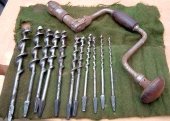




My journal documenting my time living on the Stone Baerm Homestead in summer 2021: https://permies.com/t/160807/Stone-Baerm-Adventures
 2
2





 2
2




Gardens in my mind never need water
Castles in the air never have a wet basement
Well made buildings are fractal -- equally intelligent design at every level of detail.
Bright sparks remind others that they too can dance
What I am looking for is looking for me too!

 3
3




Douglas Alpenstock wrote:
To repair, it might be useful to identify the forces that caused the failure in the first place. Was it an upward thrust or a downward thrust? How can you reinforce the pipe to spread out those stresses?
Personally before any welding, I would drill through and fasten with a bolt. And then observe the wear and tear -- a diagnostic approach.
I know, I know, not nearly as cool as laying down molten steel.
Pearl Sutton wrote:
For commercial (ab)use, I'd go for the heavier one.
My journal documenting my time living on the Stone Baerm Homestead in summer 2021: https://permies.com/t/160807/Stone-Baerm-Adventures
 4
4




I make a Maple Syrup instructional movie! Check it out HERE
SKIP books, get 'em while they're hot!!! Skills to Inherit Property
See me in a movie building a massive wood staircase:Low Tech Lab Movie




Mike Haasl wrote:Unless you are pretty darned good at welding, I think the thicker piece will be weaker. With that arrangement, all the load of the "up and down" will be on your welds. And that load will be concentrated at the top and bottom of each circle of your weld. Not much room for error.
I'd go with the sleeve myself. It will spread the load back to virgin metal and it's naturally stronger based on it's larger size. I'd make it at least 6" longer than the gap you're filling so it overlaps 3" on each end.
Doing both solutions might be even better but it's probably a lot more work and might not be that much better.
My journal documenting my time living on the Stone Baerm Homestead in summer 2021: https://permies.com/t/160807/Stone-Baerm-Adventures
 5
5




Gardens in my mind never need water
Castles in the air never have a wet basement
Well made buildings are fractal -- equally intelligent design at every level of detail.
Bright sparks remind others that they too can dance
What I am looking for is looking for me too!

 2
2




Pearl Sutton wrote:An interesting thought might be to use the other piece to reinforce the other side, so it has both of the at risk areas sturdier. Might make the mower useful longer. If one side broke, the matching point is probably irritated and likely to go next.
My journal documenting my time living on the Stone Baerm Homestead in summer 2021: https://permies.com/t/160807/Stone-Baerm-Adventures

|
You save more money with a clothesline than dozens of light bulb purchases. Tiny ad:
The new permaculture playing cards kickstarter is now live!
https://www.kickstarter.com/projects/paulwheaton/garden-cards
|





